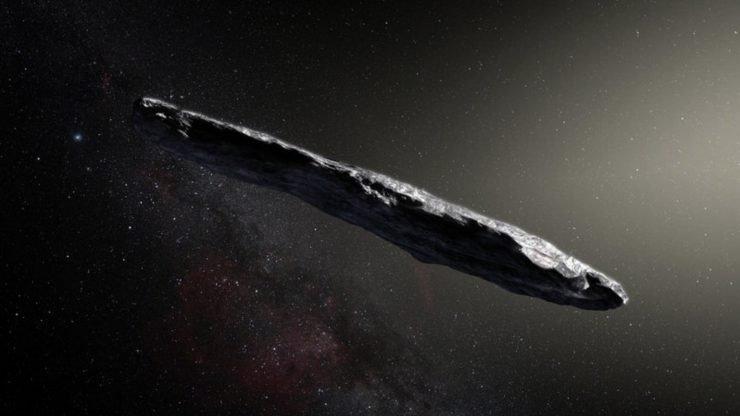To start with, this is exactly what such a craft should look like if it is star faring population. such a craft nededs to be a long cycliner that is spun up to provide natural alleration on the inside of the outer shell. Of course we are looking for multiple layers allowing a population of millions. so yes ten times larger than is is wide in completely real.
Its brightness is the other give away. This a a manfactured surface, even if it is graphene thin.
Then there is the increasing momentum. There may have been a missed earlier burn to bring the craft to insertion and the continuing acceleration is to fine tune their speed and course. All best done passing by a star.
It is even possible that it was sitting in hte orbit of saturn in order to load consumables and have launched back up to speed. again without us seeing. We already have reason to think that this is possible and happening...
Another "Oumuamua" Plot Twist: Leading Explanation For Interstellar Object Is Aliens Again
by Tyler Durden
Wed, 08/26/2020 - 21:05
Last year, an extraordinary thing happened: for the first time in recorded history, astronomers and astrophysicists observed an interstellar object enter and leave our solar system. Over the years, they’ve documented plenty of comets, asteroids, and other cosmic bodies but all have been gravitationally bound to an orbit within our star system.
This object, named ‘Oumuamua, came from outside our system, from a star or molecular cloud tens or even hundreds of millions of light-years away, and then left.
However, the most mysterious aspect of ‘Oumuamua’ was the fact that it seemed to be gaining momentum, as though it were being propelled by some kind of propulsion system. At first, astronomers tried to explain this anomaly away by contending the object was a comet, which is often naturally propelled by the burst of gas caused by melting ice. But ‘Oumuamua didn’t have the tail so common to comets that are outgassing.
So if it wasn’t a comet, how was it demonstrating non-gravitational acceleration through our cosmic neighborhood?
There were other anomalies and unusual characteristics associated with ‘Oumuamua. Why had it just been discovered so recently, when the Pan-STARRS system should have been able to spot it before? Why is its local standard of rest (LSR) frame of reference, motion, and speed so unusual? Why is its extremely elongated, cigar-like shape – with a length up to 10 times larger than its width – so rare and unlikely? Why is its surface so shiny that it reflects brightness 10 times higher than usual asteroids?
But by far, the biggest mystery was determining what was giving ‘Oumuamua that extra push of acceleration, which some scientists believed could indicate an artificial alien origin.
Finally, a new hypothesis emerged that seemed to satisfy all the criteria. Astrophysicists Darryl Seligman and Gregory Laughlin wrote a paper in which they proposed that ‘Oumuamua is a frozen comet comprised almost completely of molecular hydrogen'. This would explain, they argued, why its outgassing wasn’t producing a visible comet tail and, more importantly, it would also explain the bursts of acceleration, as “hydrogen icebergs” are theorized to behave in such ways.
“Even though the hydrogen iceberg thing is a little exotic, it explains every single mysterious thing about ‘Oumuamua,” said Seligman in an interview.
But this explanation didn’t sit right with everyone precisely because of this exotic nature: hydrogen icebergs are hypothesized to be extremely rare in the universe.
Now there’s a new twist in the mystery, as astrophysicist/cosmologist Avi Loeb is once again arguing that the hydrogen explanation is unlikely and that it’s just as possible that ‘Oumuamua really is a piece of advanced alien technology, such as a light sail-propelled spaceship. From the beginning, Loeb had argued that the object’s outlandishly rare characteristics made it seem artificial in nature
The chair of Harvard University’s Astronomy Department has co-written a new article in which he argues that ‘Oumuamua really may be humanity’s first encounter with advanced aliens, even if there are no living biological beings on-board. Loeb attempts to debunk the hydrogen iceberg theory by pointing out that such a large size would not be able to sustain chunks of frozen hydrogen, as starlight would prevent them from sticking together. More importantly, he argues, the journey from a “giant molecular cloud” – the only place where a hydrogen comet could form – would be too long for such an object to have arrived here intact.
Seligman and Laughlin countered by trying to find an origin for ‘Oumuamua, identifying relatively nearby molecular clouds formed 30 million to 45 million years ago.
But Loeb says that doesn’t work either.
“Shortening the distance that that H2 iceberg needs to travel does not solve the problems we outline in our paper, because the H2 iceberg would have formed when its parent planetary system formed, billions of years ago,” and in the time since then the comet would have fallen apart.
Loeb says that as incredible as it may seem, the leading explanation for ‘Oumuamua is that it was created as some kind of transport system or interstellar observatory for an advanced alien species. His forthcoming book “Extraterrestrial: The First Sign of Intelligent Life Beyond Earth,” will likely expand on his reasons for believing this.

No comments:
Post a Comment